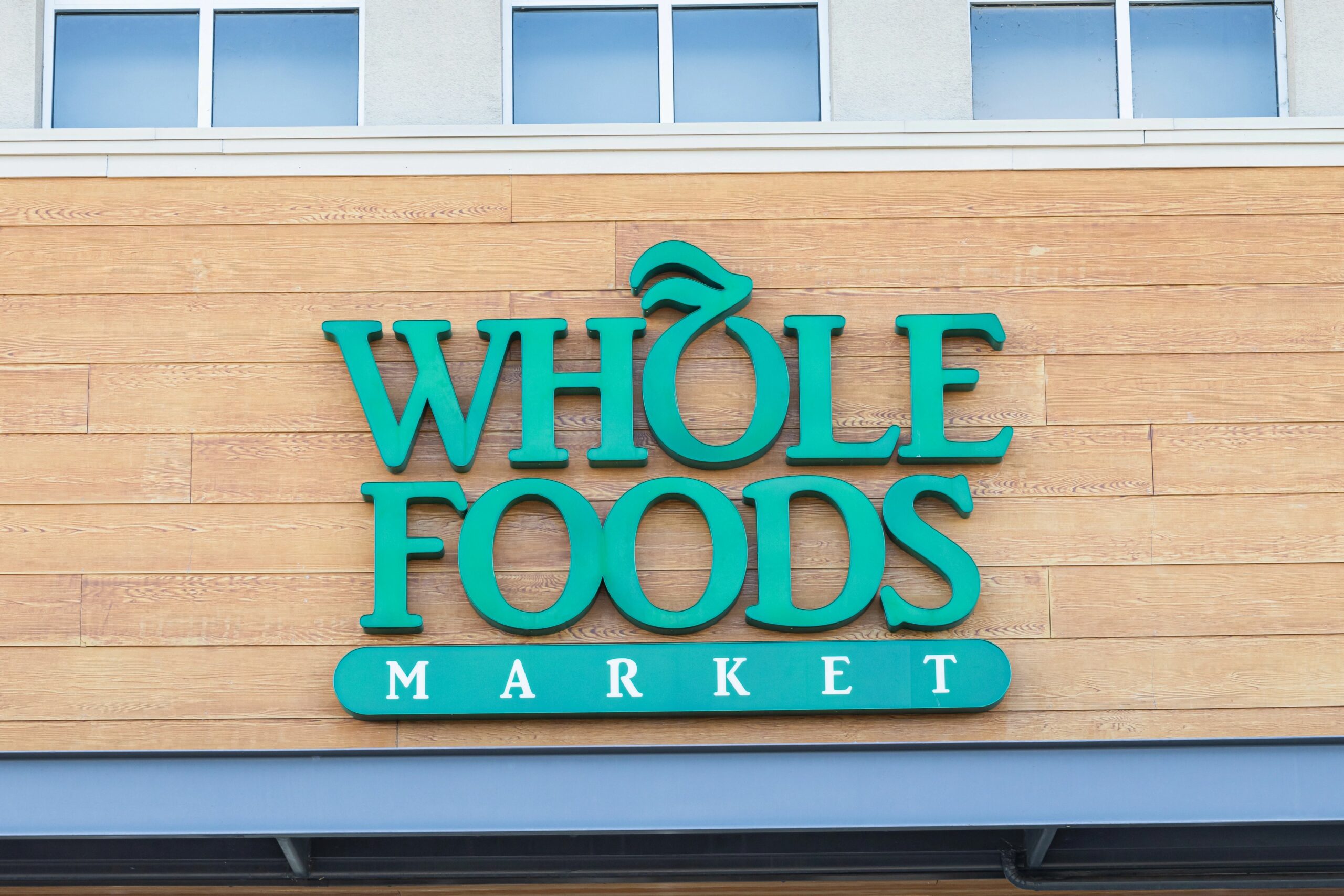
chiociolla/Depositphotos.com
November 5, 2025
Could Whole Foods’ Micro-Fulfillment Plan Dilute its Brand?
Amazon-owned Whole Foods is making a push earlier iterated by competitors like Kroger and Walmart, debuting its first micro-fulfillment center at the back of its existing market in Plymouth Meeting, Pennsylvania.
While Walmart and Kroger do not necessarily lay equivalent claim to natural, organic products that are the hallmark of the Whole Foods Market brand, the latter is leveraging its Amazon backing to the fullest extent in this proof of concept. The back-of-house micro-fulfillment center comes in at an impressive 10,000 square feet in size, and plays host to more than 12,000 unique SKUs to provide a full assortment of household goods, personal health and beauty products, snacks and beverages, and frozen foods.
Perhaps even, at least politely, admitting a bit of a pivot from business-as-usual via the inclusion of a “but” in his remarks, Whole Foods Market CEO (and VP of Amazon Worldwide Grocery Stores) Jason Buechel had the following to say.
“At Whole Foods Market, we’ve always taken pride in offering a wide selection of natural and organic products, but we understand our customers appreciate the convenience of one-stop shopping. We’re making grocery shopping more convenient for customers by thoughtfully blending our grocery offerings and leveraging new fulfillment capabilities in creative ways,” Buechel said, per a press release.
“This new concept store experience allows customers to get everything on their shopping list in one convenient stop or one online order, combining quality with convenience while still delivering the exceptional shopping experience customers expect,” he added.
Micro-Fulfillment Aims at Broadening Whole Foods Market’s One-Stop-Shop Appeal
The actual workings of the micro-fulfillment strategy are simple enough: Customers find QR codes throughout the store, which when scanned open the Amazon app leading to a custom storefront. At that time, shoppers have access to everything on-hand at the back-of-store. After placing the order — which Amazon claims often takes less than 10 minutes — shoppers get a text telling them they’re able to collect their order at the pickup and returns counter after finishing their Whole Foods checkout.
The picking and processing is largely handled by autonomous ShopBots, “keeping fulfillment activities behind the scenes to minimize disruption to the in-store experience,” as Amazon’s press release noted.
Grocery pickup is free for all customers, regardless of order size, while Amazon Prime members can also avail of delivery for a modest $9.95 fee. That fee can be waived if Prime members elect to subscribe to Amazon’s grocery subscription (at a cost of $9.99 monthly), which includes unlimited free grocery delivery on orders totaling more than $25.
Amazon indicated that, after enough feedback has been gathered from the Plymouth Meeting concept, the plan was to refine and further expand the capability to other stores in the future.
Discussion Questions
Despite clear intent to keep the front and back-of-house operations separate, will the expanded assortment have any negative effect on Whole Foods Market’s brand promise?
Are there any further steps that can be taken to protect Whole Foods’ brand from critical perceptions of having been watered down by including Amazon’s standard assortment? What might those be? Are there any valid criticisms to be made?
Poll
BrainTrust
Neil Saunders
Managing Director, GlobalData
Peter Charness
Retail Strategy - UST Global
Frank Margolis
Executive Director, Growth Marketing & Business Development, Toshiba Global Commerce Solutions
Recent Discussions








Amazon’s actions are simply following the customer. A majority of Whole Foods shoppers already buy some mainstream brands that Whole Foods does not stock, and they currently do so from retailers like Target and Kroger. Contrary to a widely held view, most Whole Foods customers do not use the chain, primarily, for healthy foods. They use it because the quality is good (that’s different to health) and they like the indulgent products offered at counters and around the perimeter of the stores. So long as Amazon doesn’t compromise on what matters and so long as it doesn’t change Whole Foods significantly, I don’t see an issue here. The only thing I would say is that the solution does seem very over-engineered – and that’s a consequence of compromise between Whole Foods’ traditional values and Amazon trying to be customer-centric.
With a disjointed shopping experience – having to stop your hands-on shopping to scan and order from your phone – will likely create a negative experience, most aptly measured by the wait time at the end and the extra walking required to go to a second counter to pickup your food. If executed to perfection, it may be only mildly annoying, but during busy times it will likely become downright inconvenient.
I will confess I’m having a little bit of difficulty in seeing how this works: are the QR codes for items not previously carried, or are they just the opposite (items formerly on the floor now moved to the back room)? I’m guessing it’s the former – which might be a positive – but will degrade to the latter – which would be a negative.
Will it dilute the brand? That depends on what we’re talking about: its rep as a laboratory? Certainly not; as a place to shop? perhaps.
This one feels pretty logical and useful to me. I can wander the store which may evolve to have a higher amount of fresh and prepared foods, and just scan my order in for shelf stable product, (that no longer needs to use up so much shelf space, leaving more room for fresh/prepared) , – All I need is the picture of a can of soup and the QR code, don’t need to pick up the product and put it in a cart, nor does whole Foods have to deal with frequent stock out scenarios. We have a smaller Whole Foods near us that does not offer a full assortment, this would help. Now the hard part is I’ve done my shopping, scanned or pick up what I wanted. Do I really have to wait around 10 minutes for the online orders to be fulfilled? I want to pay and leave….so those robots better be quick.
I just read another take on this subject posted on LinkedIn. It was written by Brittain Ladd who is known to have an opinion or two every now and then. His post gives this topic a whole different perspective. Yeah, I guess it’s a fulfillment story, but it’s also a significant rewriting of the core tenents of their Brand Promise. “One stop shopping” and “thoughtfully blending our grocery offerings” means that they will be carrying CPG products that they would never have dreamed of offering in the past. Specifically to address all the lost sales that walk out the door every day only to be purchased down the street. That sounds like a pretty big deal on all kinds of levels. It’s not surprising that they would no longer be able to resist the $$$ opportunity sitting right under their noses. But fullfillment and a dramatic change in products to be offered sound like two completely different subjects. To announce it as a fulfillment story with an “oh by the way…” on the new products to be offered appears to be an effort to mask the shift in the earth’s axis of the Whole Foods Brand Promise. And all of the questions asked by this article seem to make that point quite clearly.
Saving customers time as a one-stop shop with a more robust assortment adds to Whole Foods’ brand promise.
The in-store experience stays true to Whole Foods’ brand story with its premium natural and organic grocery leadership as the star.
CPG giants’ products are now available yet they stay hidden in Whole Foods’ back-of-house. These brands make a cameo on in-aisle digital retail media screens.
Does that imply that WF customers are still not as price sensitive?… where 1 stop is more important than $ value. (vs Walmart pricing in the main line brands).
Walmarts – for city folks- are more on the outskirts of town & are a calculated trip (in time, volume of stuff, and budget). WF could pick up incremental dollars. as their shoppers become aware of this (softer sell) service. Esp on off weeks where Walmart is not on the errands list.
Price compare in year 2026 might be the differentiator.
Kroger trips are a very ingrained in weekly habits… esp for families where big known brands make a difference to various family members.
Frankly I dont know of 1 stop shoppers. (I guess I’m city-life jaded). Where WF has less competition… will be interesting to see.
Whole Foods customers aren’t all full-on food and health brand purists, and that’s OK. Some shoppers who buy only healthier grass-fed beef and organically made foods may also want the option to buy a Coke. By keeping this option as an add-on experience to complete the basket purchase, there shouldn’t be any harm to the Whole Foods brand. And it improves sales upside for Amazon against grocery chains, Target, Walmart.
Amazon’s conversion of Whole Foods stores into premium-fronted micro-fulfillment centers offers a shrewd separation – a curated experience up front, with algorithmic efficiency out back. Customers get more from their visit, and Amazon gets fulfillment density. My concern is not brand dilution but operational friction. If those ShopBots can’t deliver in under 10 minutes consistently, customers will simply finish their grocery trip and stop by Walmart or Costco on the way home, as they have always done.